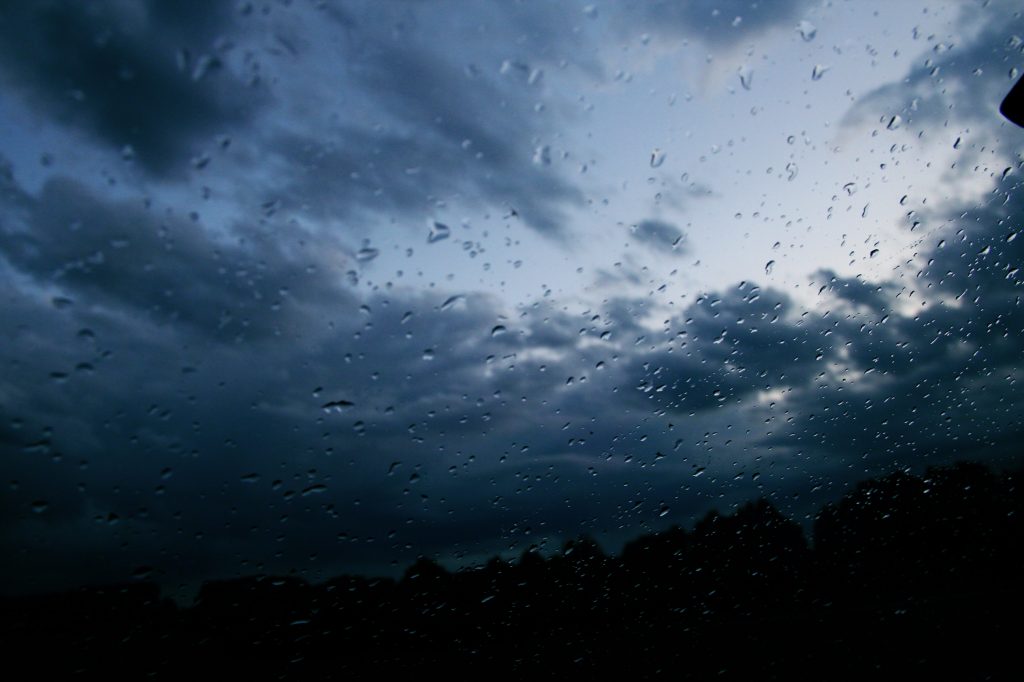It was the rainy season and Sia was sitting beside her window and enjoying the pleasant weather. It was not raining yet and there was a gentle breeze blowing. Sipping her tea, reading a book, she was in a blissful state of mind. Her bliss did not last for long though, as soon enough the weather transformed into a sinister state. The beautiful white clouds gave way to an overcast sky. As expected, in no time there was thunder and lightning and it started pouring. From her window, Sia could see people darting for cover. The street outside her house that was bustling till sometime back, was devoid of any living being except a lone vehicle trying to brave its way through the rain. Looking up at the sky, all Sia could see was an endless blanket of black clouds. She wondered why do the clouds have to assume a dark hue just before the rains.
If you have ever wondered what Sia was pensive about, we should spend sometime to understand how the process of precipitation happens.
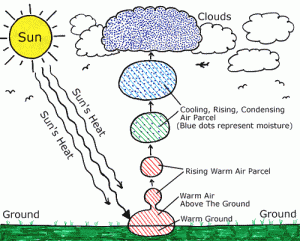 Cloud Formation
Cloud Formation
Clouds are formed when the air near the ground warms. Picking up ambient moisture, this water vapour in the air starts to rise. As the water vapour moves high in the atmosphere it gradually cools down and condenses onto the dust particles present in the air. The resulting water droplets and ice crystals coalesce, or join together, to form clouds.
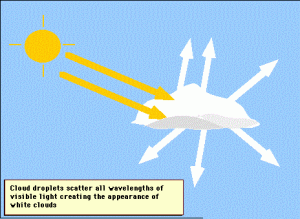 The white clouds –
The white clouds –
The Sunlight is made up of all the colours. The mixing of all the colours of the light spectrum creates white light. The atmospheric particles scatter the white light into its constituent colours.
As the colours with lesser wavelength scatters more, the sky is perceived by the human eye as blue. However, the cloud particles (the droplets and ice crystals) equally scatter all colors of light, which we perceive as white. Thus the clouds appear to be white.
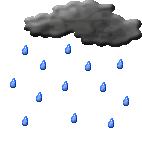 The Rain Clouds – The rain clouds are densely packed with water droplets and ice crystals. Moreover they are usually thicker, heavier and taller than their white counterparts.
The Rain Clouds – The rain clouds are densely packed with water droplets and ice crystals. Moreover they are usually thicker, heavier and taller than their white counterparts.
But Why Black?
There are a number of factors that are responsible for the greyish or blackish appearance of the rain clouds.
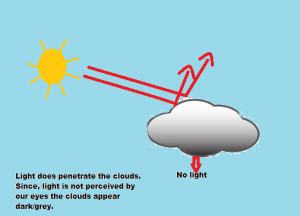 Sunlight – Being densely packed these clouds prevent the sunlight from penetrating through them and they appear darker to our eyes. Once the clouds reach about 3,000 feet in thickness, almost no light penetrates. The clouds that float between us and the sun block light from penetrating and reaching our eyes and hence give a perception of being grey or black in colour.
Sunlight – Being densely packed these clouds prevent the sunlight from penetrating through them and they appear darker to our eyes. Once the clouds reach about 3,000 feet in thickness, almost no light penetrates. The clouds that float between us and the sun block light from penetrating and reaching our eyes and hence give a perception of being grey or black in colour.
The composition – The rain clouds get thicker and denser by gathering more water droplets and ice crystals. The main reason why rain clouds are dark is due to their particulate density. The densely packed water droplets and/or ice crystals, makes the sunlight to disperse, lending a darker appearance. This effect becomes more pronounced as the water droplets becomes larger i.e. just before rains, because they become more efficient at absorbing light, rather than scattering it. Since very less or no light reaches are our eyes the clouds appear grey/ black.
Shadows – The clouds cast shadow upon one another which also contributes to the dark appearance of clods. Since the rain clouds are taller, they usually cast big shadows and the lower portions or the lower clouds do not gather as much light and appear darker.
An interesting thing.
 The same clouds that appear dark when we are on the ground could appear white when looked at from an aircraft.
The same clouds that appear dark when we are on the ground could appear white when looked at from an aircraft.
This is because the airplane is usually at a higher altitude than the clouds. So the densely packed clouds (below the height of the airplane) reflect all the sunlight, which is perceived as white by our eyes, as it has all the colours of the spectrum.
https://www.youtube.com/watch?v=UlEvT5YPDfw
So it is just the density of the cloud that changes and after that it is the light, or rather the absence of it, that makes us believe that the clouds have turned grey.
